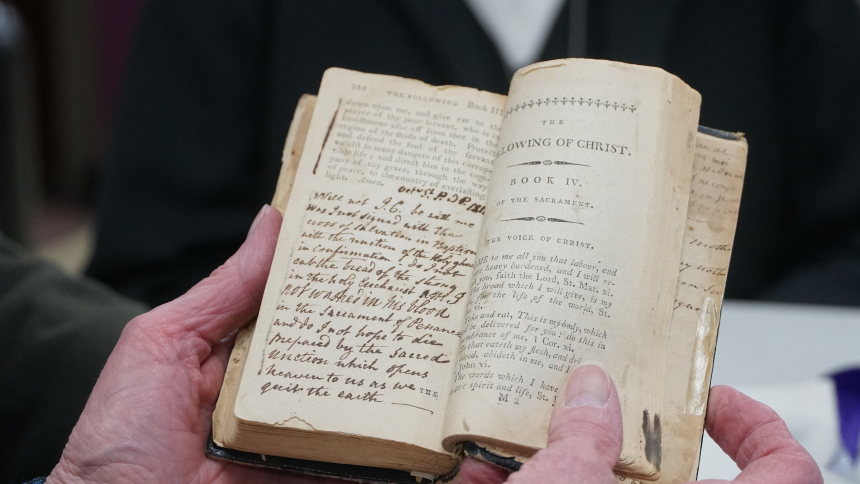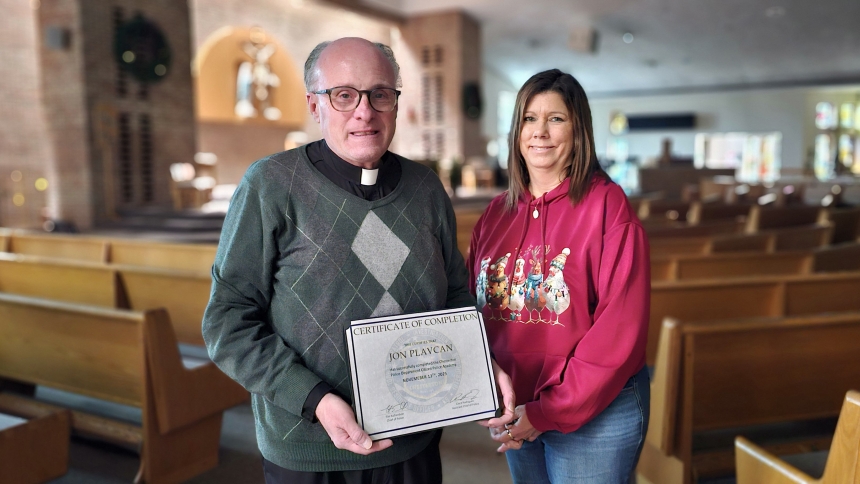
EMMITSBURG, Md. (OSV News) - The year was 1936, and Arthur Burns was in a bind. A direct descendent of Elizabeth Ann Seton, he was scouring the Northeast, looking for proof of her baptism as part of the process for her beatification.
So, on the eve of the Ascension, he found himself with the Sisters of Charity of Seton Hill in Pennsylvania, explaining how Mother Seton's Episcopal parish church in New York had burned to the ground, leaving no trace of any baptismal records. He had even reached out to relatives in England. Nothing.
As he was leaving to catch his train, according to a history prepared by the sisters, the mother superior suggested that Burns examine Mother Seton's copy of "The Following of Christ" (commonly translated as "The Imitation of Christ"). Feeling rushed by the thought of missing his train, Burns hurriedly flipped through the book and handed it back to the Reverend Mother. But another sister who was there, Sister Fides, asked permission to see the book. Before opening "The Following of Christ," she murmured a short prayer asking the Lord to let her eyes fall on words that would guide her, according to the sister's history. Then, Sister Fide's caught a glimpse of Mother Seton's handwriting on the flyleaf:
"Will not Jesus Christ be with me, was I not signed with the cross of Salvation in Baptism, with the unction of the Holy Ghost in Confirmation. Do I not eat the bread of the strong in the Holy Eucharist, am I not washed in His blood in the Sacrament of Penance, and do I not hope to die prepared by the Sacred Unction which opens Heaven to us as we quit the earth."
This was proof, in her own handwriting, of Mother Seton's baptism and testimony to her love of Christ.
Now, Mother Seton's copy of Thomas à Kempis' 15th-century classic is coming home.
Recently, the Sisters of Charity of Seton Hill agreed to loan the copy to the National Shrine of St. Elizabeth Ann Seton in Emmitsburg for display in a new $4 million museum and visitors center opening Sept. 22.
The museum will tell the life story of Mother Seton, one of the most influential people in American Catholicism, as she progressed from socialite to wife, mother, widow, foundress and, eventually, saint. On this site in Maryland, she created the first free Catholic school for girls and the first order of sisters in the U.S. The buildings where she worked, prayed and slept are open to the public, and her remains are entombed in the shrine's basilica.
"When the shrine asked us if we would lend the book, we said, 'It's not just ours. It belongs to everyone,'" said Sister Jane Ann Cherubin, general superior of the Sisters of Charity of Seton Hill. "The book has been a blessing for us, and we wanted to share it.
"We weren't saying, 'Farewell.' We were saying, 'Welcome to the bigger family.' We know display of the book will inspire others."
"The Following of Christ" is considered the second-most read book in the Christian world after the Bible, and even today, readers turn to it for guidance, inspiration and spiritual succor in tumultuous times. Based on Elizabeth Ann Seton's notes in the margins, the book played a central role in her spiritual growth as she began the steps that culminated in her canonization.
"The shrine is very grateful to the Sisters of Charity of Seton Hill for graciously lending us this book that is central to understanding Mother Seton's spirituality," said Rob Judge, executive director of the shrine. "This is a gift to all those who are devoted to Mother Seton and see her as a saint whose life and lessons remain relevant to so many of us today."
The story of her personal copy of "The Following of Christ" traces the lineage of Mother Seton's familial ancestors and those of the orders of sisters that resulted from the founding of the Sisters of Charity of St. Joseph's in Emmitsburg. That original order eventually expanded into many others and thousands of vocations that continue to provide education, health care, charity work and prayer throughout North America.
Beyond providing a vital record, Mother Seton's "The Following of Christ" also possesses special meaning to the Seton Hill sisters.
"They're the youngest daughters of Mother Seton, founded in 1870," said Casey Bowser, archivist at the Sisters of Charity and Seton Hill University. "They're an offshoot of the Cincinnati Sisters of Charity, so there's never been a direct connection to Mother Seton. This treasure provided them with a connection to her."
Kathleen Sprows Cummings, a professor at the University of Notre Dame and author of "A Saint of Our Own," added, "The book helped the community to feel closer to Mother Seton."
The book "The Following of Christ" has taken a long and circuitous route back to Emmitsburg. After Mother Seton's death in 1821, it eventually ended up with Archbishop Robert Seton, Mother Seton's grandson. It changed hands twice more before landing with Mother Aloysia Lowe, the foundress of the Sisters of Charity of Seton Hill. Perhaps not recognizing the book's value - to the order and to the world - she loaned it to another sister.
When the borrower failed to return the book after several years, Sister Electa Boyle - while writing the history of the Seton Hill sisters - requested permission to retrieve it. She wrote many inquiries about "The Following of Christ" to no avail. Finally, visiting the motherhouse in Emmitsburg, and after two weeks of hinting about the Seton Hill sisters' treasure, she took a bold approach:
"Before … her final departure, Sister Electa, dressed for traveling and carrying her satchel, went to the private office of the one who had borrowed it. Very sweetly and naively, she told her that she was ready to leave as soon as she had the little 'Following of Christ' belonging to Seton Hill in her hands. Without a word the borrowed (sic) opened her desk and gave it to her," wrote Sister Fides Glass (1890-1955) in the "Story of the Little Book."
Bowser, the archivist at the Sisters of Charity and Seton Hill University, said, "The only reason we know this story is because Sister Fides wrote it on little note cards that were kept in the archives."
With the devotional finally in hand, Sister Electa worried it might get lost or loaned again, so she sewed a special pocket for the book, where she concealed it for more than five years. Sr. Electa was unaware that Mother Seton had written in the margins "for her conscience had given her twinges every time she looked at the book," Sister Fides wrote.
Sister Electa - an early founder of Seton Hill College - finally divulged to her then-superior, Mother Rose Genevieve, that she had the book, and she surrendered it.
"In all justice and gratitude to Sister Electa this story is told," Sister Fides wrote. "If it had not been for her vision of the possible future, the little book might have been hidden away in obscurity at the very moment when it was needed."
That moment came when Burns visited the Seton Hill sisters.
Due to Sister Fides's curiosity and reverence of the book, that important notation came to light, inspiring Archbishop Michael Curley to hand-deliver a photostatic copy of the page with Mother's writing to Rome. Father Salvator Burgio, vice postulator for Mother Seton's cause, wrote Sister Fides a letter, sometime during the 1940s, saying, "'It is very true that if the notation was not found the Cause would be barricade."
Finding the passage forged a deeper connection between the saint and the sisters who trace their lineage to her.
"The Sisters of Charity Communities didn't really come together to get Mother Seton canonized until the 1940s," Bowser said. "That's when they formed the Sisters of Charity Federation to have a united effort to get Mother Seton canonized."
Originally, the Sisters of Charity were not included in the canonization documentation opened by the Daughters of Charity in Emmitsburg. The Vatican’s Congregation (now Dicastery) for the Causes of Saints questioned why the Sisters of Charity were absent from the documentation.
"The Sacred Congregation was saying you can't simultaneously say she was a founder of the Sisters of Charity and then say her cause lies exclusively with the Daughters," Cummings said.
As a side note, Cummings wrote in "A Saint of Our Own" that in 1948, Mother Seton's name was discovered on the list of communicants for New York's Trinity Church, officially confirming the future saint's baptism.
Nearly three decades later, on Sept. 14, 1975, Mother Seton was canonized in a monumental moment for American Catholicism.
Caption: This is an original copy of St. Elizabeth Ann Seton's "The Following of Christ" (commonly translated as "The Imitation of Christ”). The book testifies to her love of Jesus and the Sisters of Charity of Seton Hill in Pennsylvania agreed to loan it to the National Shrine of St. Elizabeth Ann Seton in Emmitsburg, Md., for display in the shrine's new $4 million museum and visitors center opening Sept. 22, 2023. (OSV News photo/courtesy National Shrine of St. Elizabeth Ann Seton)


